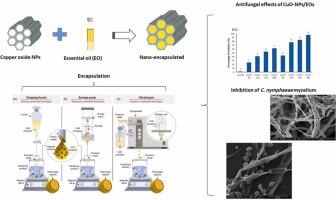Industrial Crops and Products ( IF 5.6 ) Pub Date : 2024-06-22 , DOI: 10.1016/j.indcrop.2024.119051 Weria Weisany , Solmaz Pourbarghi Soufiania , Javad Razmi , Alireza Hosseinzadeh Eshaghadadi

|
Nanotechnology has become a driving force in several sectors, particularly in improving plant disease control and agricultural practices. It is predicted that the integration of nanotechnology into research will revolutionise the management of post-harvest losses in horticultural crops. The emergence of resistant fungal strains due to the overuse of artificial antifungals highlights the need for alternative solutions. Harnessing the natural antifungal properties of plant essential oils (EOs) encapsulated in environmentally friendly nanosystems shows promise in addressing this challenge. The aim of this study was to evaluate the efficacy of encapsulating EOs extracted from fenugreek (Trigonella foenum-graecum) and coriander (Coriandrum sativum) within copper oxide nanoparticles (CuO-NPs) against Colletotrichum nymphaeae. The study showed that the EOs derived from fenugreek and coriander plants significantly inhibited the growth of C. nymphaeae mycelium. This inhibition was observed at concentrations of 600 and 900 ppm after 3 and 6 days of incubation. CuO-NPs effectively inhibited the growth of C. nymphaeae mycelium at various concentrations over different incubation periods, with the highest inhibition (approximately 99.9 %) observed at 900 ppm after six days. Encapsulation of these EOs in CuO-NPs showed synergistic effects against C. nymphaeae, achieving over 90 % inhibition of mycelial growth. Furthermore, the use of CuO-NPs encapsulated EOs resulted in a significant reduction in mycelial growth at different concentrations and time points. When fenugreek EOs were encapsulated with CuO-NPs, they had a stronger impact on the growth of C. nymphaeae mycelium compared to coriander EO. This impact was discernible across concentrations ranging from 90 to 900 ppm. Over an incubation period spanning 3, 6, 9, and 12 days, the inhibitory effects were observed to be 100 %, 100 %, 95.6 %, and 96.7 %, respectively. This study highlights the potential of encapsulated EOs as effective antifungal agents for pathogen control, offering practical solutions for disease management in agriculture.
中文翻译:

使用氧化铜纳米粒子对胡芦巴和香菜精油进行纳米封装:增强其对抗炭疽菌功效的新方法
纳米技术已成为多个领域的驱动力,特别是在改善植物病害控制和农业实践方面。据预测,纳米技术与研究的结合将彻底改变园艺作物收获后损失的管理。由于过度使用人工抗真菌药物而出现的耐药真菌菌株凸显了对替代解决方案的需求。利用封装在环保纳米系统中的植物精油 (EO) 的天然抗真菌特性有望解决这一挑战。本研究的目的是评估将从胡芦巴 (Trigonella foenum-graecum) 和香菜 (Coriandrum sativum) 中提取的 EO 封装在氧化铜纳米颗粒 (CuO-NP) 中对抗炭疽病菌的功效。研究表明,来自胡芦巴和香菜植物的环氧乙烷显着抑制睡莲菌丝体的生长。孵育 3 天和 6 天后,在 600 和 900 ppm 浓度下观察到这种抑制作用。 CuO-NPs 在不同的培养期内以不同浓度有效抑制睡莲菌丝体的生长,六天后在 900 ppm 时观察到最高抑制率(约 99.9%)。将这些 EO 封装在 CuO-NP 中显示出对睡莲的协同作用,实现了超过 90% 的菌丝生长抑制。此外,使用 CuO-NPs 封装的 EOs 在不同浓度和时间点导致菌丝体生长显着减少。当用 CuO-NPs 封装胡芦巴 EO 时,与香菜 EO 相比,它们对睡莲 EO 菌丝体的生长有更强的影响。这种影响在 90 至 900 ppm 的浓度范围内是明显的。 在 3、6、9 和 12 天的潜伏期内,观察到抑制效果分别为 100%、100%、95.6% 和 96.7%。这项研究强调了封装环氧乙烷作为有效抗真菌剂控制病原体的潜力,为农业疾病管理提供了实用的解决方案。
















































 京公网安备 11010802027423号
京公网安备 11010802027423号